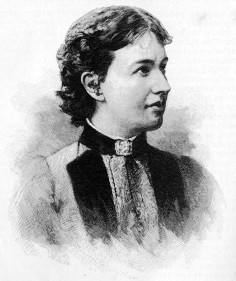Sonya Kovalevsky
Today, strange wallpaper, and an unexpected mathematician. The University of Houston's College of Engineering presents this series about the machines that make our civilization run, and the people whose ingenuity created them.
Here's a photo of a woman in her mid-thirties -- a striking, open, strong-featured face. She is Sonya Kovalevsky. Born to a tyrannical Russian general in 1850 in a remote country estate in tsarist Russia, she was raised by a series of governesses. She was complex -- willful and shy, brilliant and torn by self-doubt.
When she was little, the estate was re-wallpapered. The paper ran out before they'd finished her nursery, so someone contrived to cover it with pages from her father's old calculus text. Sonya grew up gazing at those pages, craving to understand them. When she reached university age she wanted to study mathematics.
Russian universities didn't accept women, and her father wouldn't let her go to Germany alone. So she made him believe that she was having an affair with a young paleontologist, Vladimir Kovalevsky. Her father demanded a shotgun wedding.
As a married woman, she could travel freely, first to Heidelberg, then Berlin. Berlin was no more willing to accept women students than Russia. But then the great mathematician Weierstrass saw her brilliance. He took her on as a private pupil and a life-long friend. She did her doctorate on partial differential equations and wrote several important papers. At the age of 25, she returned to Moscow and to her husband. When she couldn't find work there, she tried Paris. While she was in Paris, her husband died.
Finally the Swedes gave her a teaching post in Stockholm. During her seven years in Sweden, the extent to which she lived her life between emotional highs and lows became very evident. The year 1889 was a high. She wrote a remarkable prize-winning paper on rotating bodies. But she also wrote her second novel.
Writing had been her other passion for a long time. During her late teens, she, her older sister, and her mother had spent time in St. Petersburg visiting Dostoevsky. In any event, like her mathematics, the novel also won high critical praise.
Two years later she was deeply depressed. Then she caught the flu on a trip back from Moscow and died at only 41. All her life she'd drawn people into her terribly focused life, and she had consumed them. However, she'd added significantly and permanently to our understanding of differential equations and applied mechanics.
She was the first woman mathematician in modern times to gain full academic recognition for her genius. A century later, her native country, which had not welcomed her brilliance while she lived, issued a stamp with her portrait on it.
No doubt she'd been isolated by her wealth as a child. But papering her room with that mad wallpaper had awakened one of the great minds of an age. Little Sonya Kovalevsky gazed at those mystic symbols on the wall and saw what we must all eventually see -- that what one person can do, another can also do. A little girl saw that those symbols were not beyond her grasp at all.
I'm John Lienhard, at the University of Houston, where we're interested in the way inventive minds work.
(Theme music)
Hapgood, I. F., Notable Women: Sonya Kovalevsky. Century Magazine, August 1895, pp. 536-539. This article, written by a woman with a late nineteenth-century perspective, paints a dreary picture of Kovalevsky's life and concludes: "... it would seem ... that a masculine head united to a feminine heart is likely to prove a very unhappy combination for a woman."
Osen, L.M., Women in Mathematics. Cambridge, MA: MIT Press, 1974.
This is a greatly revised version of Episode 225.
Hapgood includes the following image of Sonya Kovalevsky, copied from a Russian photo. (For the more striking original, see Osen's book, above):
